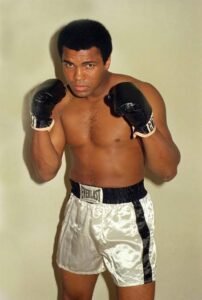
Ali’s grandson wins second professional fight APTOPIX Pacquiao Ugas Boxing. Today we will discuss about Muhammad Ali Boxer: What Inspired| What’s Wrong| Disease
Muhammad Ali Boxer: What Inspired| What’s Wrong| Disease
Muhammad Ali (born Cassius Marcellus Clay Jr.; [4] January 17, 1942 – June 3, 2016) was an American professional boxer, activist, entertainer, poet, and philanthropist. Nicknamed The Greatest, he is widely regarded as one of the most important and famous sports figures of the 20th century. He is often ranked as the greatest heavyweight boxer of all time, [5] [6] [7] and in 1999 he was named Player of the Century by Sports Illustrated and BBC Sports Personality of the Century.
| Born |
Cassius Marcellus Clay Jr.
January 17, 1942 Louisville, Kentucky, U.S.
|
|---|---|
| Died | June 3, 2016 (aged 74)
Scottsdale, Arizona, U.S.
|
| Resting place | Cave Hill Cemetery, Louisville, Kentucky |
| Monuments |
|
| Education | Central High School (1958) |
What Inspired

Without question, Muhammad Ali (who passed away on June 3, 2016) changed the world of sports. Winning the heavyweight title three times—beginning with his shocking upset over Sonny Liston in 1964, which made him the youngest boxer to defeat a current heavyweight champion—Ali is considered alongside Joe Lewis and Sugar Ray Robinson. One of the best boxers of all time. Enter a ring. Although his pugilistic style was unorthodox and a disgrace to boxing purists at the time, his dazzling combination of speed and power revolutionized the sport, and most boxing observers now agree with Ali’s longtime boast that he “Greatest ever”. ,
But while his achievements in the ring earned him Sports Illustrated’s “Sportsman of the Century” title in 1999, it was Ali’s appeal outside the arena that made him perhaps the most recognizable and beloved person on the planet. Other than Jackie Robinson, who broke baseball’s racial barrier in 1947, none can match his impact as a 20th-century American sports person. Only his mind and mouth were sharper than his fists and feet: speaking truth to power, insolent Ali, in a confrontational, even “arrogant” manner, said such things as mainstream America. Wasn’t ready to listen yet, especially out of mouth. of a young black man.
What’s Wrong

Cassius Marcellus Clay Jr. ( KASH-əss) was born on January 17, 1942, in Louisville, Kentucky. He had a brother. He was named after his father, Cassius Marcellus Clay Sr., who had one sister and four brothers [25] [26] and who himself was named in honor of Cassius Marcellus Clay, a 19th-century Republican politician and staunch abolitionist . Kentucky State. Clay’s father’s grandparents were John Clay and Sally Anne Clay; Clay’s sister Eva claimed that Sally was a native of Madagascar. [27] He was a descendant of slaves from the Antebellum South, and was of predominantly African descent, with some Irish [28] and English family heritage. [29] [30] Ali’s great-grandfather, Abe Grady, came from Ennis, Company Clare, Ireland. [31] [32] DNA testing in 2018 revealed that, through his maternal grandmother, Ali was a former slave archer. Alexander, who was chosen from the building crew as the model for a free man for the Emancipation Monument, and was the subject of abolitionist William Greenleaf Eliot’s book, The Story of Archer Alexander: From Slavery to Freedom. [33] Like Ali, Sikandar also fought for his independence.
Disease
Dad has always liked movies about fighters.
An underdog has the allure of seeing a rise in fame. Maybe he’s charmed by the strength of characters like Rambo and Muhammad Ali because he hopes there’s a fighter in him too. He will not define himself by his circumstances or sink into apathy. Instead, he steps into the boxing ring, raises his hand, and vows to fight his best.
Dad took a special interest in Muhammad Ali, one of the most accomplished boxers in history. His legacy lived on even when he was diagnosed with early Parkinson’s disease. Maybe my dad sees himself in Ali, considering himself a literal and figurative fighter. Like Ali, he fights Parkinson’s every day.
step into the ring
Ali was not just a fighter. He was funny, charming and amusing – the stuff of legends. After winning the gold medal at the 1960 Olympic Games at the age of 18, he continued to rise to fame, becoming only a three-time heavyweight world champion. He adopted a royal attitude when faced with challenges and won the hearts of America.
In 1971, Ali faced Joe Frazier in the biggest boxing match in history. Both men were undefeated when they stepped into the ring. After 15 heartbreaking rounds, Frasier emerged victorious, but in 1974 and 1975, the men faced each other again.
Ali was declared the winner both times.
In reference to his fight with Frazier, Ali said, “I once read something that said, ‘He who is not courageous enough to take risks will not achieve anything in life. Boxing is a risk and life One is a gamble, and I have to take both.”
Ali and Parkinson
In the late 1970s, the public noticed a change in Ali’s tempo and speech. However, he was not actually diagnosed with Parkinson’s until 1984, at the age of 42. The news came only three years after he formally retired from boxing.
It is generally speculated that Ali’s boxing career was linked to his development of Parkinson’s. h
